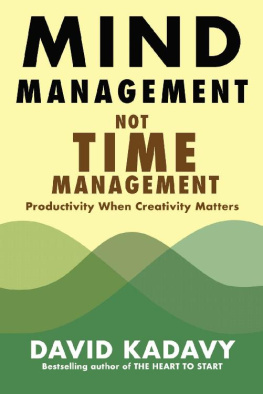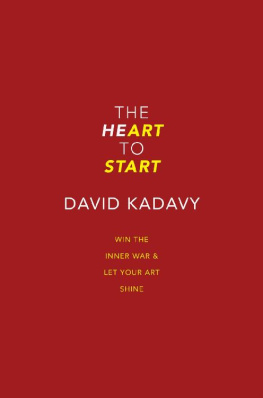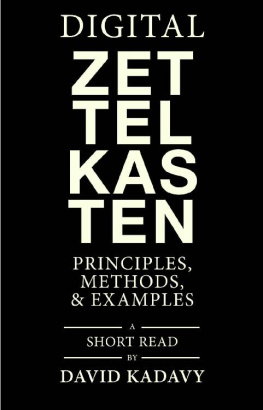Design for Hackers
Reverse-Engineering Beauty
David Kadavy

Design for Hackers
This edition first published 2011
2011 Kadavy, Inc.
Registered office
John Wiley & Sons, Ltd, The Atrium, Southern Gate, Chichester, West Sussex, PO19 8SQ, United Kingdom
For details of our global editorial offices, for customer services and for information about how to apply for permission to reuse the copyright material in this book please see our website at www.wiley.com.
The right of the author to be identified as the author of this work has been asserted in accordance with the Copyright, Designs and Patents Act 1988.
All rights reserved. No part of this publication may be reproduced, stored in a retrieval system, or transmitted, in any form or by any means, electronic, mechanical, photocopying, recording or otherwise, except as permitted by the UK Copyright, Designs and Patents Act 1988, without the prior permission of the publisher.
Wiley also publishes its books in a variety of electronic formats. Some content that appears in print may not be available in electronic books.
Designations used by companies to distinguish their products are often claimed as trademarks. All brand names and product names used in this book are trade names, service marks, trademarks or registered trademarks of their respective owners. The publisher is not associated with any product or vendor mentioned in this book. This publication is designed to provide accurate and authoritative information in regard to the subject matter covered. It is sold on the understanding that the publisher is not engaged in rendering professional services. If professional advice or other expert assistance is required, the services of a competent professional should be sought.
Trademarks: Wiley and the Wiley Publishing logo are trademarks or registered trademarks of John Wiley and Sons, Inc. and/ or its affiliates in the United States and/or other countries, and may not be used without written permission. iPhone, iPad and iPod are trademarks of Apple Computer, Inc. All other trademarks are the property of their respective owners. Wiley Publishing, Inc. is not associated with any product or vendor mentioned in the book. This book is not endorsed by Apple Computer, Inc.
A catalogue record for this book is available from the British Library.
978-1-119-99895-2
Set in 11pt Adobe Garamond Pro by Wiley Composition Services
Printed in the United States by CJ Krehbiel
About the Author
David Kadavy is president of Kadavy, Inc., a user interface design consultancy with clients including oDesk, PBworks, and UserVoice, and mentor at the 500 Startups seed fund. Previously, David led the design departments of two Silicon Valley startups and an architecture firm, taught a college course in typography, and studied ancient typography in Rome while earning his BFA in graphic design at Iowa State University. Davids design work has been featured in Communication Arts magazine, and he has spoken at the South by Southwest (SXSW) Interactive conference. David blogs about design and entrepreneurship at kadavy.net and can be reached on Twitter at the handle @kadavy or by e-mail at david@kadavy.net.
Dedication
To my parents, Reed and Marilyn Kadavy, for encouraging me to follow my curiosity.
Credits
Some of the people who helped bring this book to market include the following:
Editorial and Production
VP Consumer and Technology Publishing Director
Michelle Leete
Associate DirectorBook Content Management
Martin Tribe
Associate Publisher
Chris Webb
Publishing Assistant
Ellie Scott
Development Editor
Elizabeth Kuball
Copy Editor
Elizabeth Kuball
Technical Editor
Jason Simanek
Editorial Manager
Jodi Jensen
Senior Project Editor
Sara Shlaer
Editorial Assistant
Leslie Saxman
Marketing
Associate Marketing Director
Louise Breinholt
Marketing Executive
Kate Parrett
Composition Services
Compositor
Indianapolis Composition Services
Proofreader
Susan Hobbs
Indexer
Slivoskey Indexing Services
Acknowledgments
It seems strange that I should even have the privilege of putting my name on the front of this book, as it is a product of the work, talent, and inspiration of so many people. I have merely synthesized and filtered stimuli and processed it as best I could with the point of view that I have formed over the years.
More than anyone, I would like to thank my acquisitions editor, Chris Webb, for having the vision and guts to publish a book that another publisher dismissively referred to as ambitious. I would also like to thank my editor, Elizabeth Kuball, for her invaluable guidance and skill in turning what can sometimes be an incoherent mess into writing that I am truly proud of. I also want to thank my technical editor, Jason Simanek; Im so grateful that our kindred yet complementary minds were finally able to collaborate, and Im so glad that you were up for the challenge when it arrived.
The content of this book has been reviewed by a few enthusiastic reviewers who selflessly donated their time and intelligence for no more payment than what I presume to be a premature satiation of their curiosity and what follows. So, thank you Chris Duesing, Zack Gilbert, Jacob Rus, and Paul Stamatiou.
A great deal of useful knowledge is still locked up in libraries around the world, but the incredible amount of information and visual resources freely available on the Internet made writing this book much easier. So, thank you to all the great contributors to the Internet, from Wikipedia contributors, to bloggers, to photographers and illustrators who make their work available under a Creative Commons license on Flickr, Wikimedia, or anywhere else.
The viewpoint I present in this book is, in part, thanks to the influence of my professors at Iowa State University. Thank you to Arthur Croyle, who was the best teacher I could have had to teach me about the origins of typography in Rome. Thank you also to Gary Tartakov, whose lectures shared a socioeconomic viewpoint on design and art history like none other. Thank you to Paula Curran, whose methodical approach to design problems was an inspiration.
The content and point of view of this book are also a product of the influence of artists, authors, designers, architects, teachers, and entrepreneurs, as well as anyone, anywhere, ever, who has had the bravery to truly explore what he or she had to offer the world. I will certainly leave out someone deserving of mention, but here is my attempt: Jan Tschichold, Robert Bringhurst, Malcom Gladwell, Seth Godin, Tim Ferriss, Steve Jobs, Vincent van Gogh, Dave Eggers, Jane Austen, and Mies van der Rohe. Thanks to all of you, to the first person to ever discover how to start a fire, and to anyone who ever did anything novel and creative thereafter and taught someone else about it.
This book probably never would have been written were it not for an unlikely chain of events that brought me the privilege of living and working in Silicon Valley during one of its most exciting periods. That time exposed me to the most creative cowboys and cowgirls Ive ever encountered, so thank you to all of you and to everyone I ever met who was like you but didnt happen to live in Silicon Valley. So, thank you to Jeff Cannon and Jon Stevenson for getting me there. Also, thank you to Vinnie and Kristine Lauria, Noah Kagan, Paul Bragiel, and Ramit Sethi for being inspiring in your own ways. I would have put all of you in the preceding paragraph, but because I know you personally, that would have been weird.















